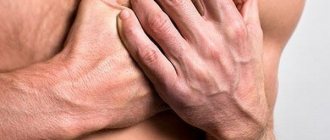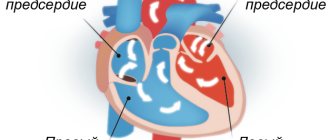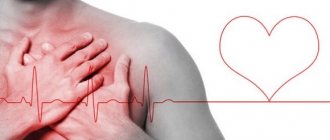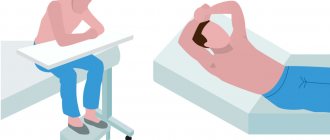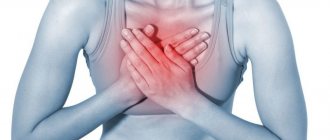Heart pain in children
General information
Pain in the heart area in children is one of the common reasons for visiting a doctor. It is important for the doctor to clarify their localization, time of appearance, constancy or sporadicness of painful phenomena, intensity, distribution, connection of pain with physical or psycho-emotional stress and other factors. It is important to identify the factors that cause and relieve pain. Painful sensations in the heart in children are mainly stabbing in nature (86.9%), localized in the apex of the heart (96.1%), provoked by a stressful situation (79.6), do not radiate, are not associated with physical activity, decrease or disappear when the child’s attention is diverted, as well as after taking sedatives.
Causes of heart pain in children
Heart pain in children most often has a functional nature and, as a rule, may not be associated with heart pathology. Cardialgia in children of early school age is usually a manifestation of the so-called growth disease, when the intensive growth of the heart muscle outstrips the growth of the vessels supplying blood to this organ.
Such pain usually occurs in asthenic, emotional, active children against the background of physical activity , fast walking or running. Once the child stops, rests, calms down, the pain goes away. Such cardialgia is usually of a stabbing nature and can be repeated not once, but periodically over several months. Heart pain in adolescence is usually associated with a violation of the autonomic regulation of the heart, that is, it is a manifestation of vegetative-vascular dystonia . Pain in the heart during VSD is also more often of a stabbing nature, localized in the left half of the chest, the left axillary region, and can occur in a calm state. Very often, in a child, the pathology of other organs and systems simulates pain in the heart. In the first place is the pathology of the spine (scoliosis, early osteochondrosis). In second place is the pathology of the nervous system (neuroses and others) And, finally, the pathology of the gastrointestinal tract:
- biliary dyskinesia;
- cholecystocholangitis.
Typical for children is the inability to correctly localize the source of pain. So, for example, with abdominal pain, a small child may point to the chest, the area of the heart. Pain in neuroses is usually localized in the region of the heart itself (at the apex), can be stabbing, aching in nature, and is accompanied by a number of emotional manifestations and motor restlessness. Sharp pain with inspiration, coughing , or other respiratory movements usually points to the pleura and pericardial region or mediastinum as a possible source of pain, although pain in the chest wall is also likely to be influenced by respiratory movements. Similarly, pain that regularly occurs when walking quickly and disappears within a few minutes after stopping is still considered a typical sign of angina, although similar phenomena may occur in patients with skeletal disorders and injuries. Particular attention should be paid if heart pain in a child occurs against the background of an acute current illness (ARVI, influenza), which may indicate the development of viral myocarditis . And also if pain occurs 2-3 weeks after suffering from a sore throat or scarlet fever. After such a time after streptococcal infection, rheumatism begins. With such serious complications as myocarditis and rheumatism, in addition to pain in the heart, other complaints are also disturbing:
- signs of intoxication;
- malaise;
- joint pain;
- interruptions in the heart.
In such a situation, you should immediately consult a doctor. Cardialgia associated with heart damage in children is observed with:
- abnormal coronary circulation;
- pericarditis;
- with a sharp expansion of the heart or great vessels.
With an anomalous coronary origin of the left coronary artery from the pulmonary artery (Blandt-White-Garland syndrome), squeezing, squeezing pain, localized behind the sternum, can radiate to the neck, jaw, and shoulders. Postcardiotomy syndrome : dull pain behind the sternum, fever, arthralgia appear several weeks after surgery, accompanied by opening of the heart cavity, in 30% of operated children. Characterized by expansion of the borders of the heart, increased ESR, increased antibodies to the heart muscle in the blood, which is considered as a hyperergic reaction of the body to damage to the cells of the heart muscle.
Other causes of pain
With pericarditis, there can be two types of heart pain. Pleural pain associated with respiratory movements and aggravated by coughing and (or) deep inspiration is caused by the pleuritic component of infectious pleuropericarditis. The second type of pericardial pain is a pressing retrosternal pain simulating myocardial infarction or angina.
Pain is caused by inflammation of the sensitive internal parietal surface of the pericardium or irritation of the afferent nerve fibers of the heart lying in the periadventitial layer of the superficial coronary arteries. Pain caused by pericarditis is usually expressed as a feeling of pressure. It occurs with infectious or rheumatic pericarditis . The intensity of the pain varies from slight to severe, the pain intensifies with movement and deep inhalation. When dry pericarditis transitions to exudative, pain stops, and at the same time, muffled heart sounds, venous congestion, and a triangular mediastinal shadow appear.
Dull, prolonged pain in the heart area, sometimes with a strong tingling sensation, as well as pain radiating to the left arm and shoulder, as with angina pectoris, can be caused by myocarditis or pericarditis due to acute enlargement of the heart. If the pain is combined with a friction noise synchronous with heartbeats, visible venous congestion in the veins of the neck and hepatomegaly, one should think about pericarditis (characteristic of the x-ray configuration of the heart). It is also a mistake to believe that heart pain in a child is a manifestation of a heart defect. Congenital heart defects often have other clinical signs. If pain in the heart occurs in an apparently healthy child, but is repeated repeatedly, and the child focuses on it, then there is a need to visit a pediatrician or pediatric cardiologist. It is possible that after examining the heart (ECG and ultrasound), consultations with other specialists will be needed: a neurologist, an orthopedist, a gastroenterologist. They will be able to choose the optimal solution that will help the child recover as soon as possible.
What parents should pay attention to
Painful sensations occur with cardiac and non-cardiological diseases in children. If the baby begins to periodically complain of pain in the heart area, parents need to pay attention to the following symptoms:
- frequency and duration of complaints, ask about the nature of pain;
- did shortness of breath appear after active games or swimming;
- listen to the chest for an increase or decrease in heart rate, check the pulse;
- periodically ask if there is any dizziness or nausea;
- check for swelling (do not confuse swelling with growth or weight gain);
- pay attention to nutrition and whether there are any pain syndromes after eating, remember what kind of food it was;
- find out if it is sometimes difficult to hold a spoon or cup in your hands, if there is discomfort when walking; in older children, find out if the limbs are going numb.
It is important to remember everything in detail and at the doctor’s appointment to list what exactly is bothering the baby. More complete information will help the doctor correctly and quickly make a diagnosis and prescribe treatment. You should not delay your visit to the clinic.
How to strengthen a child's heart
One of the most important indicators of a child’s health is the condition of his heart, which, at the same time, is subject to the greatest danger. Every year, an increasing number of childhood heart diseases are being identified, which can be either congenital or acquired. There are many reasons for this:
- Exposure of a pregnant woman to hazardous production during work;
- Previous intrauterine infections;
- Pathology of a genetic nature;
- Excessive loads;
- Sedentary lifestyle;
- Complications from previous colds;
- Incorrect or unbalanced diet.
Where to start?
Of course, every expectant mother wants to have a healthy baby. But this needs to be taken care of in advance - before he is born, and even before conception. To do this, a woman must first take care of her health in order to give her child strong immunity. Constant walks in the fresh air, proper nutrition, and a healthy lifestyle contribute to this. You need to avoid contact with sick people and take care of yourself both before and during pregnancy. You need to forget about bad habits, if not for your own sake, then certainly for the sake of your future generation. Moreover, this also applies to the second parent, and in general to all family members - nicotine has no place in the house where a newborn appears, and passive smoking in this regard is even more dangerous than active smoking.
Nutrition for a child's heart
The right foods strengthen the heart of the expectant mother and child. In particular, these are:
- Lean meats;
- A variety of vegetables, fruits, nuts, grains and herbs;
- Fish;
- Fermented milk dishes.
Cereals and sprouted seeds play a special role among this diversity. Thanks to them, it is possible to avoid excess cholesterol in the blood and the detection of diabetes in the future. They are rich in microelements and vitamins valuable for heart health - B, K, C, E, zinc, potassium, magnesium. Daily “oatmeal” in the morning will saturate the body with fatty acids, strengthen the heart muscle, and cleanse the body of harmful toxins.
The green color of vegetables seems to symbolize growth, strength, and health for the body and heart. The tops of vegetables, which can be used for food, turn out to be much healthier than the rhizomes themselves. During the season of green leafy vegetables, you should include large quantities of lettuce and beets, radishes, carrots, radishes, spinach and broccoli in your daily diet. They just contain a sea of microelements! Children enjoy eating green smoothies and salads seasoned with vegetable oils: olive, flaxseed, sesame. All this is very useful for the child’s immunity and growing bones, and also helps strengthen the barrier to harmful bacteria, tumors and viruses. Vegetable oils are also an excellent preventative against constipation and parasites, which children are often susceptible to.
Nuts are a real storehouse of fats, without which it is difficult for the heart to function normally. It is enough for a child to eat at least a handful of peanuts, walnuts or almonds a day, and, among other things, his body will be provided with vitamin E and protein, thinking, memory and other useful functions of the brain will develop.
Fruits, vegetables and berries are also good for nourishing a child's heart. There are many of them, but apples, tomatoes, blueberries and rowan, especially chokeberries, are of particular importance in this regard. Tasty and healthy berry, vegetable and fruit juices and teas will also appeal to children; it is useful to alternate them with herbal infusions. And no sweet, salty or fatty excesses!
Movement is life, but without fanaticism!
You should not let your child sit in one place for a long time, especially in front of the TV, telephone or computer. Excessive enthusiasm for studying, when there is no time left for outdoor games and other movement, can cause no less harm to children's health. A sedentary lifestyle, especially coupled with an unhealthy diet, will quickly lead to obesity, which cannot but affect the heart. If the problem is already evident, then you need to immediately contact the children's clinic, without waiting for even greater complications.
The child’s movement and rest should not only be complete, but also within reason. Sleep is one of the important moments, it should be on schedule, and in the morning a light warm-up is necessary. Walks must be included in the morning, afternoon or evening, but before exposing the child’s body to great physical activity, you should consult a doctor. Sports are good, but excessive stress is dangerous for the heart, especially for children, especially if they already have health problems. Dancing, swimming pool, karate, etc. - any section should begin with a cardiologist and end with him. Not a single child’s complaint should be left unattended!
Heart and weight
It is necessary to maintain a healthy weight for the child. Due to poor nutrition (chips, soda, snacks on the go) and poor diet, today there are many overweight children. Obesity puts additional stress on the heart.
Remember that coffee and energy drinks should not be consumed before the age of 16.
Develop your child's habit of eating healthy foods from childhood, as well as leading an active lifestyle.
Colds - no
Heart disease can be triggered even by a common cold, which drags on over time and develops into more severe forms of the disease.
Sore throat and infectious diseases can leave a mark on a child’s heart.
Therefore, it is important to strengthen the child’s immunity and not allow him to suffer from a cold on his feet. At the Clinic of Allergy and Pediatrics, a pediatric cardiologist will give you recommendations on how to strengthen your child’s heart, tell you how to eat properly, follow a daily routine, and what sports activities are necessary. Do not neglect the advice of specialists!
How to quickly help your child
If pain does not go away within a short time, parents do not need to panic, because with their behavior they can frighten the baby even more. You need to provide the child with enough fresh air and call an ambulance.
Before the doctors arrive, a tablet of glycine, valerian or validol is allowed if the child is over 5 years old. The child does not always make contact with an unfamiliar doctor, so before the doctor arrives, you should try to find out what type of pain the child is experiencing, how much it hurts, and the exact location of the pain. You need to ask in a calm, confident voice, and don’t get nervous if the baby can’t answer intelligibly.
Classification of pneumonia
Types of pneumonia are classified according to the cause. The type of microorganism involved, the location where the child was infected, and how the infection occurred are taken into account. According to the conditions of infection, hospital-acquired (nosocomial), intrauterine and community-acquired pneumonia in children is distinguished. The most common type of disease is the latter, which develops at home mainly against the background of ARVI.
Types of pneumonia in children according to the classification used in clinical practice:
· Focal.
The focus of infiltration has a diameter of 0.5 to 1 cm. Individual areas of infiltration can merge, which leads to the formation of a large focus.
· Segmental.
An entire segment of the lung may be involved in the inflammatory process. It is protracted and often complicated by fibrosis or deforming bronchitis.
· Croupous.
It is characterized by a hyperergic inflammatory process that affects the pleural area.
· Interstitial.
Accompanied by proliferation and infiltration of connective tissue. Develops when affected by fungi, viruses and pneumocystis.
According to the severity of the disease, complicated and uncomplicated pneumonia are distinguished. When complications develop, pulmonary edema, pulmonary insufficiency, pleurisy or abscess are observed. Cardiovascular disorders cannot be excluded.
Along the way, protracted and acute pneumonia in children are distinguished. In the second case, the disease resolves within 4-6 weeks. In a prolonged form, the inflammatory process persists for more than one and a half months. According to etiology, fungal, bacterial, viral and parasitic pneumonia are distinguished.
The clinical classification of childhood pneumonia is important for doctors, because, knowing the place and time of infection of the child, it is possible to determine the form of the pathogen that caused the pneumonia and, accordingly, prescribe effective treatment.
Pneumonia in children - treatment at the RebenOK clinic in Moscow
Our medical center employs pediatricians who have extensive practical experience. Treatment of pneumonia in children is carried out after confirming the diagnosis and determining the type of pathogen, which allows you to get a quick result. Competent specialists determine the symptoms of latent pneumonia in children, which occurs without fever and wheezing.
If signs of a cold appear, it is recommended to consult a pediatrician to rule out the presence of pneumonia or prevent the development of the disease. We use modern diagnostic equipment and prescribe treatment in accordance with international protocols, taking into account the individual characteristics of the patient.
Literature:
1. Erzhanova G.E. Pneumonia in children // Bulletin of the Kazakh National Medical Institute, 2014. URL: https://cyberleninka.ru/article/n/pnevmonii-u-detey (access date: 09/02/2021)
2. Sergeeva E.V., Petrova S.I. Community-acquired pneumonia in children. Modern features // Pediatrician Magazine, 2021. URL: https://cyberleninka.ru/article/n/vnebolnichnaya-pnevmoniya-u-detey-sovremennye-osobennosti (access date: 09/02/2021)
3. Geppe N.A., Kozlova L.V., Kondurina E.G. Community-acquired pneumonia in children // Clinical manual "Moscow Society of Children's Doctors", 2021. URL: https://pulmodeti.ru/wp-content/uploads/Vnebolnichnaya.pdf (access date: 09/02/2021)
4. Petchenko A.I., Luchaninova V.N., Knysh S.V.
Age-related features of the course of community-acquired pneumonia in children // Journal “Fundamental Research” No. 2, 2014. URL: https://fundamental-research.ru/ru/article/view?id=33563 (access date: 09/02/2021) 5. Kakeeva A.A., Bokonbaeva S.D., Dzhanabilova G.A. Etiological structure of community-acquired pneumonia in young children // Journal “Modern Problems of Science and Education” No. 3, 2021. URL: https://science-education.ru/ru/article/view?id=30897 (access date: 02.09. 2021)
